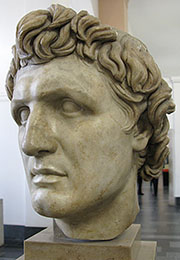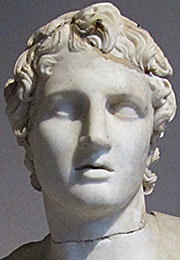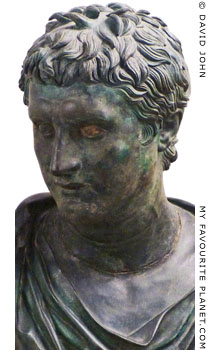This strong, larger than life-size portrait of Attalus I (269-197 BC), depicted as a serious, masculine warrior with tousled hair, is in the Hellenistic style made popular following much-copied statues of Alexander the Great in the 4th century BC (see photos on gallery 2, page 2 and Alexander the Great).
The head of white marble, 39.5 cm high, was found during excavations in 1905-1906, in a later defensive wall at the entrance to Room H of the gymnasium on the south side of the upper terrace of the Pergamon Acropolis.
Pergamon Museum, Berlin.
Inv. No. AvP VII 130.
Attalus I, first king of Pergamon
One of the first decrees of Attalus I (Ἄτταλος, Attalos, 269-197 BC, ruled 241-197 BC) banned the payment of tributes demanded by the Gauls who in 278 BC had settled in the area of central Anatolia which was to become known as Galatia. The Celtic warriors attacked Pergamon, causing severe losses to the Attalus' forces. However, the next year he managed to turn the tide against them and their Seleucid allies, and by 227 BC he had totally destroyed the Gallic threat. His victories made him a popular hero throughout the Greek world, and Epigonus built a memorial to them in Athens.
Attalus I became known as Soter (Σωτὴρ, Saviour) and was the first Attalid to take the title king (238 BC). On Pergamon's Acropolis he built a gallery for sculptures which included the famous Dying Gaul, a copy of which is in now Rome. He also began the building of the Pergamon Library, which was to became the second most important in the ancient world after the Library of Alexandria in Egypt. (There were actually two libraries at Alexandria, but that's another story). The building of the library was continued in grand style by his son Eumenes II (see the History of Pergamon page).
In Asia he had several victories and setbacks as he attempted to seize territory from the Seleucids, and he eventually turned his attentions westwards to Greece.
Significantly, he also allied himself with Rome which meanwhile had become the dominant power in the Mediterranean and was rapidly taking over Greek territories in Europe. At the time, many Greek states, including Athens, welcomed the interventions by Attalus and the Romans against Philip V of Macedon in the first and second Macedonian Wars. During these wars Attalus gained the Aegean islands of Aegina (see History of Pergamon) which he made his base of operations, Andros and Euboea.
In 201 BC Philip V invaded Pergamon, but due to Attalus' improved fortifications he was unable to take the city and had to satisfy himself by destroying temples and altars outside the walls.
In 200 BC Attalus was given a hero's welcome in Athens, and an Athenian tribe was named Attalis in his honour. Pergamon had arrived as a power to be reckoned with in the Aegean, and Attalus had further enriched the city with the booty he had taken from defeated enemies.
The period of his reign was marked by wars throughout Asia and the Mediterranean, including Rome's war against Hannibal of Carthage. The stakes were very high, as the losers were either slaughtered or enslaved and the winners gained power, territory, slaves and riches; mercy was in very short supply.
Attalus, as one of the winners, was able to live to the ripe old age of 72 and leave a stable family and kingdom to his four sons. In 197 BC, during the Second Macedonian War (200-197 BC), he collapsed from a stroke while giving a speech to a Boeotian council in Thebes. Partly paralyzed, he was taken home to Pergamon where he died in the same year, either before or shortly after the Battle of Cynoscephalae, in which Philip V was defeated, bringing about the end of the war.
See also History of Pergamon. |

The head of Attalus I
from a different angle. |
| |

Alexander the Great
Head of a marble statue
signed by Menas of Pergamon.
From Magnesia ad Sipylum,
Lydia (Manisa, Turkey).
Mid 3rd century BC.
Istanbul Archaeological
Museum. Inv. No. 709.
Cat. Medel 536. |
| |

Bronze head known as
"the Young Commander",
thought to be a portrait
of Eumenes II (ruled
197-159 BC), son and
successor of Attalus I.
Found in the Villa of the
Papyri, Herculaneum. The
bust is modern. Height 56 cm.
National Archaeological
Museum, Naples.
Inv. No. 5588. |
|